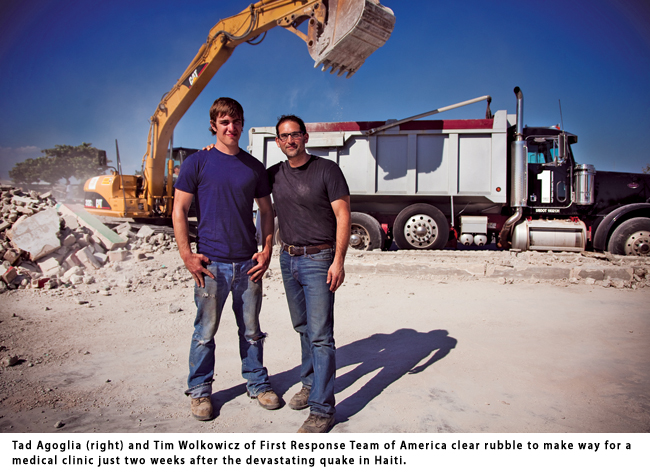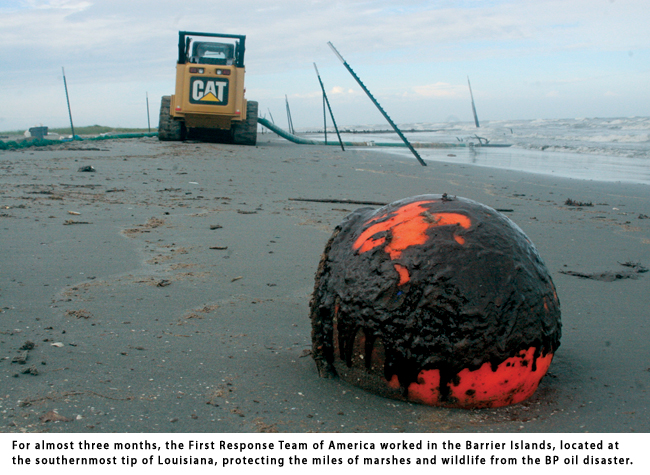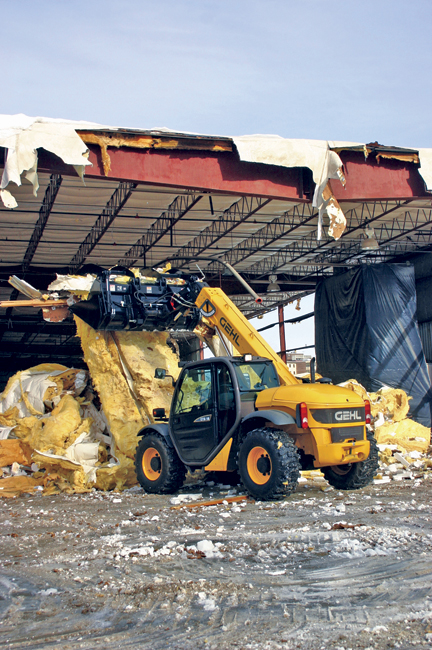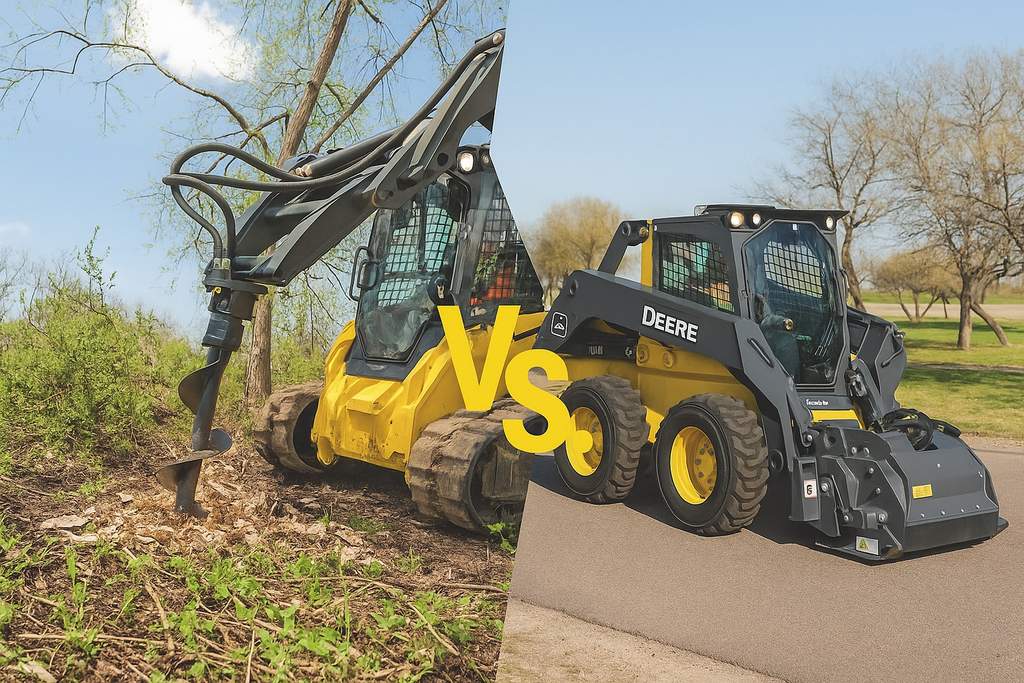Good Works
Heroes take journeys, and Tad Agoglia took plenty of journeys last year. As the chairman and CEO of the First Response Team of America, a non-profit disaster relief organization, his job is to travel to hurricane, flood, oil spill or earthquake emergencies to help rebuild communities after a major calamity.
“There’s something about that moment in time when you’re standing with these people in their freshly destroyed community and you’re helping them in a way where they can see and feel it,” said Agoglia in our January 2010 cover story. “It has nothing to do with making money, but getting these people back on their feet again.”
At the core of Agoglia’s relief efforts is a fleet of compact machinery. Using diverse and nimble machines like skid steers, track loaders and even a mini hovercraft, the First Response Team of America helps clean up neighborhoods, restore order after a devastating storm and give a community hope in its darkest hour. Since we talked with Agoglia last year about his mission and his machines, we’ve been tracking his humanitarian efforts across America and beyond. Here are those stories.
Medical Clinic in Cité Soleil, Haiti
On Jan. 12, 2010, a 7.0 earthquake hit the impoverished island nation of Haiti. The First Response Team of America made a decision to respond and commissioned a second fleet of equipment from TowMaster, Cat dealer Cleveland Brothers Equipment Co. and The Pete Store, specifically designed to meet the needs in Haiti without compromising its domestic response capabilities. In Cité Soleil, one of the poorest and most dangerous communities in Haiti, the team cleared the rubble around a two-acre compound so that local workers could build a new structure, creating a safe environment for the distribution of food, medical supplies and tents. Other aid organizations were able to use the secure area as a makeshift medical clinic to position their doctors to care for tens of thousands in need of medical attention. This medical facility continues to be instrumental in the cholera epidemic that this area of Haiti is currently facing.
Rhode Island Response
Historic flooding bombarded the Northeast on March 31, 2010. A storm drenching Rhode Island with several inches of rain caused widespread flooding. Among the worst areas hit, the Pawtuxet River in Cranston crested at 12 ft above flood stage, the worst flooding seen in 100 years. Despite the mandatory evacuations, many were left stranded due to the swiftly rising waters. Using their hovercraft, the team worked with the Cranston Fire Department performing water rescues of those stranded, returning them to their families. “Since this is one of the record floods that we’ve experienced here in the City of Cranston, our local resources were maxed out. Today, First Response Team showed up and they offered us assistance of a hovercraft, [which was] invaluable in helping us,” said James Gumbley, fire chief of Cranston, R.I.
Mission of Alabama
The team deployed to Albertville, Ala., in April where many homes were damaged or completely destroyed by an EF4 tornado. A sizeable band of storms traversing Mississippi and Alabama created an EF4 twister, which touched down in Albertville and resulted in downed trees and power lines, destroyed homes and barns. Arriving on the scene within a day of the touchdown, the team helped the community clear their lots and remove what was left of their homes so they could begin anew. They pulled trees out of houses for people who could simply not have afforded to do so on their own.
Gulf Oil Spill Disaster and Relief
After receiving a warm welcome from The National Guard, the Team supported the Guard in the construction of tiger dams to create a wall about 20 ft from the shore line and help prevent oil from reaching land, where cleanup efforts would become much more difficult. Though the responders were able to contain some of the oil, the spill was simply too massive for any crew to hold back. The Team spent many emotional days watching the waves become red and the white sand turning black. For two months, they worked in the Barrier Islands, located at the southernmost tip of Louisiana — built many years ago to prevent the ocean from taking over the marshes and grasslands of Louisiana. The first waves of the oil spill would surely attack these islands first, so cleanup efforts were concentrated on these islands to help protect the miles of marshes and wildlife that lay behind.
Hurricanes and Floods
Through the rest of 2010 the team stayed busy. They followed Hurricane Earl in September to North Carolina and Massachusetts after it first struck the Caribbean Islands, and then moved its way up to the East Coast, finishing its furry in Nova Scotia, Canada. Crews were also sent to Tropical Storm Hermine in Missouri and Arkansas in September 2010. By October, the team was in Windsor and Wilmington, N.C., battling high waters. After a severe drought, 22 in. of rain fell in the Wilmington area in five days, causing flooding. There was limited damage, despite the severity of the weather, but the team was there helping wherever it could.
Donate to the First Response Team of America
Please support the First Response Team’s efforts as they bring help and hope to those affected by disasters. A tax deductible contribution can be made on their website or can be enclosed in the envelope to the address below. Please make any checks payable to “First Response Team” and designate your check if you would like it to go to a specific disaster. Thank you for your consideration. “We could not do the work we do without your generous support.” — First Response Team of America, 200 Prosperity Rd., Knoxville, TN 37923 (www.firstresponseteam.org).
The Long Reach of Relief
Telescopic Tool Carriers Give a Big Lift in Disaster Applications
By John Rau
Telescopic handlers are no strangers to disaster relief sites. Their ability to reach, lift, pick, place and carry a wide variety of attachments make them extremely useful when it comes to site cleanup. Telescopic “tool carriers” are even more valuable to disaster relief applications because not only can they pick and place and reach and lift like other telescopic handlers, but they can also dig, push, pull and twist like a standard loader. Featuring a stout boom with a wider nose that’s constructed with heavier steel so that it can handle the torsional forces of ground-engaging machines, high reach tool carriers like the Gehl CT Series telescopic loaders do all the work of their telescopic handler counterparts and then some.
Telescopic loaders have advantages over a standard loader in a disaster relief situation as well. One advantage is the machine’s ability to carry a larger attachment. More material can be moved with a 1.75-cu yd grapple bucket vs. a smaller grapple on a standard loader. Plus, lifting capacities range from 5,000 to 7,000 lbs, which is significantly higher than most standard loaders. In addition, these machines have ground speeds from 15 to 25 mph enabling them to move faster across the site. The ability to lift and reach over obstacles adds to the appeal of a telescopic loader over a standard loader. An operator can reach up 15 ft to pick up a load without driving over sensitive ground or further damaging property.
Any good telescopic loader comes fully equipped with road ready lights, wipers and an enclosed cab so they can work in virtually all conditions. Loader-style joystick controls are standard equipment and are optimal for lifting and dumping. Telescopic handlers in a disaster relief application are outfitted a little differently. Foam filled or solid tires are common. This reduces or eliminates the hassle of dealing with flat tires. A windshield guard is also a common accessory. This protects the shield from damage if an object were to come loose in the load and fall on the FOPS/ROPS. The best attachments for disaster relief would be a scrap grapple (a combination of a bucket and a grapple), a spring tooth skeletal bucket and a standard bucket with a replaceable cutting edge.
In many disaster relief situations the ground is saturated or loose, so the operator needs to practice caution and be aware of sink holes or soft spots the machine could get stuck in. Flat tires can be easily avoided by equipping the machine with foam filled or solid tires as mentioned above. Be aware of overhead wires since the telescopic loader can reach higher than a standard loader.
Remember to always carry the load (boom) as low to the ground as possible to prevent the machine from tipping over while moving. Don’t forget to perform daily maintenance checks. Keeping an eye on the health of the machine can help prevent an accident and avoid downtime. Finally, operators should always read the operator’s manual provided by the manufacturer to ensure they know the specific use of their machine. Be sure to stay within the load charts on capacities and follow all warning decals provided on the machine by the manufacturer.
John Rau is a product specialist for Gehl Co., based in West Bend, Wis.








Comments are closed here.